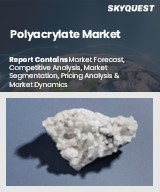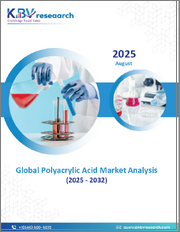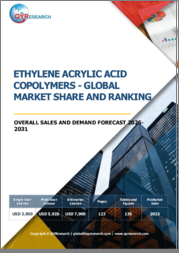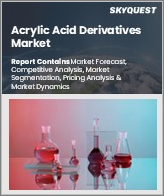
|
시장보고서
상품코드
1606873
세계의 아크릴산 에틸 시장 : 유형별, 용도별 예측(2025-2030년)Ethyl Acrylate Market by Type (Crosslinkable Ethyl Acrylate, High-Purity Ethyl Acrylate, Industrial Grade Ethyl Acrylate), End-Use (Leather, Packaging, Paints and coatings) - Global Forecast 2025-2030 |
||||||
아크릴산 에틸 시장은 2023년에 48억 9,000만 달러로 평가되었고, 2024년에는 51억 1,000만 달러에 이를 것으로 예측되며, CAGR 4.86%로 성장하고, 2030년에는 68억 2,000만 달러에 달할 것으로 예상됩니다.
아크릴산 에틸은 폴리머나 코폴리머의 제조에 모노머로서 널리 사용되는 무색의 액체이며, 다양한 산업에 있어서 중요한 빌딩 블록으로서 기능합니다. 제, 섬유제품, 플라스틱 등 다방면에 걸친 아크릴산에틸의 필요성은 감압접착제, 도료나 코팅제, 섬유마감제의 제조에 있어서의 역할에 의해 강조되어 많은 생산공정에서 필수적입니다. 도로는 자동차, 건축, 섬유, 포장 등 강화된 성능의 재료를 요구하는 산업이 중심입니다. 게다가, 전자상거래의 확대로 인한 포장 업계의 성장이 수요를 뒷받침하고 있습니다. 지속가능한 생산방식과 생분해 성의 대체품으로 혁신을 일으키면 비즈니스를 유리하게 전개할 수 있습니다. 아크릴산 에틸에 대한 노출과 관련된 건강에 대한 우려도 과제이며, 고급 안전 조치와 규제 준수가 필요합니다. 환경에 미치는 영향을 줄이기 위한 재활용 기술, 다양한 용도를 위한 고도의 복합재료의 조합 등 기술 혁신의 부름이 되는 분야가 있어 사업 성장의 길이 열리고 있습니다. 이를 활용하기 위해 기업은 지속 가능한 관행에 초점을 맞추고 전략적 제휴 및 파트너십을 추구하여 시장 전문 지식을 공유하고 업계 규제 변화 및 기술 발전에 신속하게 대응할 수있는 적응력 어떤 비즈니스 모델을 유지해야합니다.
| 주요 시장 통계 | |
|---|---|
| 기준년(2023) | 48억 9,000만 달러 |
| 추정년(2024) | 51억 1,000만 달러 |
| 예측년(2030) | 68억 2,000만 달러 |
| CAGR(%) | 4.86% |
시장 역학: 빠르게 진화하는 아크릴산 에틸 시장의 주요 시장 인사이트 공개
아크릴산 에틸 시장은 수요 및 공급의 역동적인 상호 작용에 의해 변모를 이루고 있습니다. 새로운 비즈니스 기회를 획득할 수 있습니다. 이러한 동향을 종합적으로 파악함으로써 기업은 정치적, 지리적, 기술적, 사회적, 경제적 영역에 걸친 다양한 리스크를 경감할 수 있을 뿐만 아니라 소비자 행동과 그것이 제조 비용과 구매 동향에 미치는 영향을보다 명확하게 이해할 수 있습니다.
- 시장 성장 촉진요인
- 세계의 건축 및 건설 활동 증가
- 최종 용도 분야에서의 접착제 및 밀봉제 수요 증가
- 폴리머 생산에 있어서 광범위한 사용
- 시장 성장 억제요인
- 에틸아크릴레이트의 생산에 필요한 원료 비용의 변동
- 시장 기회
- 아크릴산 에틸레이트의 제조 공정에 있어서의 기술의 진보
- 수처리 약품이나 퍼스널케어 제품에 있어서의 새로운 치료법
- 시장의 과제
- 에틸아크릴레이트의 생산과 사용에 관한 엄격한 규제
Porter's Five Force : 아크릴산 에틸 시장을 탐색하는 전략 도구
Porter's Five Force Framework는 시장 상황경쟁 구도를 이해하는 중요한 도구입니다. 프레임워크는 기업이 시장 내 세력도를 평가하고 신규 사업의 수익성을 판단하는 데 도움이 됩니다. 보다 강인한 시장에서의 포지셔닝을 확보할 수 있습니다.
PESTLE 분석 : 아크릴산 에틸 시장에서 외부로부터의 영향 파악
외부 거시 환경 요인은 아크릴산 에틸 시장의 성과 역학을 형성하는 데 매우 중요한 역할을합니다. 영향을 탐색하는 데 필요한 정보를 제공합니다. PESTLE 요인을 조사하면 기업은 잠재적인 위험과 기회를 더 잘 이해할 수 있습니다. 예측하는 적극적인 의사 결정을 할 준비가되어 있습니다.
시장 점유율 분석 : 아크릴산 에틸 시장 경쟁 구도 파악
아크릴산 에틸 시장의 상세한 시장 점유율 분석을 통해 공급업체의 성과를 종합적으로 평가할 수 있습니다. 이를 통해 시장의 집중, 단편화, 통합 동향을 밝혀내고, 벤더는 경쟁이 격화하는 가운데 자신의 지위를 높이는 전략적 의사결정을 하기 위해 필요합니다. 지식을 얻을 수 있습니다.
FPNV 포지셔닝 매트릭스 : 아크릴산 에틸 시장에서 공급업체의 성능 평가
FPNV 포지셔닝 매트릭스는 아크릴산 에틸 시장에서 벤더를 평가하는 중요한 도구입니다. 네 가지 사분면을 통해 벤더를 명확하고 정확하게 분할하고 전략 목표에 가장 적합한 파트너 및 솔루션을 파악할 수 있습니다.
전략분석 및 추천 : 아크릴산에틸 시장에서 성공을 위한 길을 그리기
아크릴산에틸 시장의 전략 분석은 세계 시장에서의 프레즌스 강화를 목표로 하는 기업에 필수적입니다. 이 접근법을 통해 경쟁 구도에서 과제를 극복하고 새로운 비즈니스 기회를 활용하여 장기적인 성공을 거둘 수 있는 체제를 구축할 수 있습니다.
이 보고서는 주요 관심 분야를 포괄하는 시장의 종합적인 분석을 제공합니다.
1. 시장 침투: 현재 시장 환경의 상세한 검토, 주요 기업의 광범위한 데이터, 시장 도달범위 및 전반적인 영향력 평가.
2. 시장 개척도: 신흥 시장의 성장 기회를 파악하고 기존 분야의 확장 가능성을 평가하며 미래 성장을 위한 전략적 로드맵을 제공합니다.
3. 시장 다양화: 최근 제품 출시, 미개척 지역, 업계의 주요 진보, 시장을 형성하는 전략적 투자를 분석합니다.
4. 경쟁 평가 및 정보 : 경쟁 구도를 철저히 분석하여 시장 점유율, 사업 전략, 제품 포트폴리오, 인증, 규제 당국 승인, 특허 동향, 주요 기업의 기술 진보 등을 검증합니다.
5. 제품 개발 및 혁신 : 미래 시장 성장을 가속할 것으로 예상되는 최첨단 기술, R&D 활동, 제품 혁신을 강조합니다.
또한 이해관계자가 충분한 정보를 얻고 의사결정을 할 수 있도록 중요한 질문에 대답하고 있습니다.
1. 현재 시장 규모와 향후 성장 예측은?
2. 최고의 투자 기회를 제공하는 제품, 부문 및 지역은 어디입니까?
3. 시장을 형성하는 주요 기술 동향과 규제의 영향은?
4. 주요 벤더의 시장 점유율과 경쟁 포지션은?
5. 벤더 시장 진입·철수 전략의 원동력이 되는 수익원과 전략적 기회는 무엇인가?
목차
제1장 서문
제2장 조사 방법
제3장 주요 요약
제4장 시장 개요
제5장 시장 인사이트
- 시장 역학
- 성장 촉진요인
- 세계에서 건축 및 건설 활동이 증가
- 최종 용도 분야에 있어서의 접착제 및 실란트 수요 증가
- 폴리머의 제조에 널리 사용되고 있다
- 억제요인
- 에틸아크릴레이트의 생산에 필요한 원재료의 변동 비용
- 기회
- 아크릴산 에틸레이트의 제조 공정에 있어서의 기술적 진보
- 수처리 약품이나 퍼스널케어 제품에의 새로운 용도
- 과제
- 에틸아크릴레이트의 제조 및 사용에 관한 엄격한 규제
- 성장 촉진요인
- 시장 세분화 분석
- Porter's Five Forces 분석
- PESTEL 분석
- 정치적
- 경제
- 사교
- 기술적
- 법률상
- 환경
제6장 아크릴산에틸 시장 : 유형별
- 교차 결합 가능한 아크릴산 에틸
- 고순도 아크릴산에틸
- 공업 등급 아크릴산 에틸
- 의약품 등급 아크릴산 에틸
- 중합 가능한 아크릴산에틸
- UV 경화형 아크릴산에틸
제7장 아크릴산에틸 시장 : 최종 용도별
- 가죽
- 패키지
- 페인트 및 코팅
- 종이
- 플라스틱
- 섬유
제8장 아메리카의 아크릴산에틸 시장
- 아르헨티나
- 브라질
- 캐나다
- 멕시코
- 미국
제9장 아시아태평양의 아크릴산 에틸 시장
- 호주
- 중국
- 인도
- 인도네시아
- 일본
- 말레이시아
- 필리핀
- 싱가포르
- 한국
- 대만
- 태국
- 베트남
제10장 유럽·중동 및 아프리카의 아크릴산에틸 시장
- 덴마크
- 이집트
- 핀란드
- 프랑스
- 독일
- 이스라엘
- 이탈리아
- 네덜란드
- 나이지리아
- 노르웨이
- 폴란드
- 카타르
- 러시아
- 사우디아라비아
- 남아프리카
- 스페인
- 스웨덴
- 스위스
- 터키
- 아랍에미리트(UAE)
- 영국
제11장 경쟁 구도
- 시장 점유율 분석 2023
- FPNV 포지셔닝 매트릭스, 2023
- 경쟁 시나리오 분석
- 전략 분석과 제안
기업 목록
- Arkema SA
- Ataman Kimya Ltd.
- BASF SE
- DuPont de Nemours, Inc.
- Eastman Chemical Company
- Entec Polymers
- Evonik Industries AG
- LG Chem
- Merck KGaA
- Mitsubishi Chemical Corporation
- Mitsui Chemicals, Inc.
- Nippon Shokubai Co., Ltd.
- Santa Cruz Biotechnology, Inc.
- Sasol Limited
- SimSon Pharma Limited
- Solvay SA
- Sumitomo Chemical Co., Ltd.
- The Dow Chemical Company
- The Lubrizol Corporation
- Thermo Fisher Scientific Inc.
- Tokyo Chemical Industry Co., Ltd.
- Toronto Research Chemicals
- Univar Solutions Inc.
- Wacker Chemie AG
- Zhengzhou Meiya Chemical Products Co., Ltd.
The Ethyl Acrylate Market was valued at USD 4.89 billion in 2023, expected to reach USD 5.11 billion in 2024, and is projected to grow at a CAGR of 4.86%, to USD 6.82 billion by 2030.
Ethyl acrylate is a colorless liquid extensively used as a monomer in the production of polymers and copolymers, which serve as crucial building blocks in various industries. The scope of ethyl acrylate extends across numerous applications including adhesives, coatings, textiles, and plastics, driven by its excellent adhesive properties and flexibility. The necessity for ethyl acrylate is underscored by its role in manufacturing pressure-sensitive adhesives, paint and coating formulations, and textile finishes, making it indispensable in numerous production processes. The end-use scope predominantly spans industries such as automotive, construction, textiles, and packaging, all seeking enhanced performance materials. Key growth factors include rising demand in the construction sector for specialized coatings and adhesives, and increasing application in the automotive industry for lightweight materials. Furthermore, growth in the packaging industry driven by e-commerce expansion bolsters demand. Potential market opportunities lie in developing eco-friendly variants, as rising environmental concerns lead to stricter regulations. Innovating in sustainable production methods or biodegradable alternatives could position businesses favorably. However, the market faces limitations such as volatile raw material prices and stringent regulations regarding volatile organic compound (VOC) emissions, which could impede growth. Challenges also stem from health concerns related to ethyl acrylate exposure, necessitating advanced safety measures and regulation compliance. Nevertheless, areas primed for innovation include green technology developments, recycling techniques to reduce environmental impact, and formulation of advanced composites for diverse applications, offering avenues for business growth. The nature of the ethyl acrylate market is dynamic, characterized by continuous evolution in technology and regulatory landscapes. To capitalize on current trends, companies should focus on sustainable practices, pursue strategic alliances or partnerships to share market expertise, and maintain an adaptive business model that can swiftly respond to regulatory changes and technological advancements in the industry.
| KEY MARKET STATISTICS | |
|---|---|
| Base Year [2023] | USD 4.89 billion |
| Estimated Year [2024] | USD 5.11 billion |
| Forecast Year [2030] | USD 6.82 billion |
| CAGR (%) | 4.86% |
Market Dynamics: Unveiling Key Market Insights in the Rapidly Evolving Ethyl Acrylate Market
The Ethyl Acrylate Market is undergoing transformative changes driven by a dynamic interplay of supply and demand factors. Understanding these evolving market dynamics prepares business organizations to make informed investment decisions, refine strategic decisions, and seize new opportunities. By gaining a comprehensive view of these trends, business organizations can mitigate various risks across political, geographic, technical, social, and economic domains while also gaining a clearer understanding of consumer behavior and its impact on manufacturing costs and purchasing trends.
- Market Drivers
- Rise in building and construction activities worldwide
- Growing demand for adhesives and sealants in end-use sectors
- Extensive use in the production of polymers
- Market Restraints
- Fluctuating cost of raw material required for the production of ethyl-acrylate
- Market Opportunities
- Technological advancements in the manufacturing process of ethyl-acrylate
- Emerging use in water treatment chemicals and personal care products
- Market Challenges
- Stringent regulation pertaining to the production and use of ethyl-acrylate
Porter's Five Forces: A Strategic Tool for Navigating the Ethyl Acrylate Market
Porter's five forces framework is a critical tool for understanding the competitive landscape of the Ethyl Acrylate Market. It offers business organizations with a clear methodology for evaluating their competitive positioning and exploring strategic opportunities. This framework helps businesses assess the power dynamics within the market and determine the profitability of new ventures. With these insights, business organizations can leverage their strengths, address weaknesses, and avoid potential challenges, ensuring a more resilient market positioning.
PESTLE Analysis: Navigating External Influences in the Ethyl Acrylate Market
External macro-environmental factors play a pivotal role in shaping the performance dynamics of the Ethyl Acrylate Market. Political, Economic, Social, Technological, Legal, and Environmental factors analysis provides the necessary information to navigate these influences. By examining PESTLE factors, businesses can better understand potential risks and opportunities. This analysis enables business organizations to anticipate changes in regulations, consumer preferences, and economic trends, ensuring they are prepared to make proactive, forward-thinking decisions.
Market Share Analysis: Understanding the Competitive Landscape in the Ethyl Acrylate Market
A detailed market share analysis in the Ethyl Acrylate Market provides a comprehensive assessment of vendors' performance. Companies can identify their competitive positioning by comparing key metrics, including revenue, customer base, and growth rates. This analysis highlights market concentration, fragmentation, and trends in consolidation, offering vendors the insights required to make strategic decisions that enhance their position in an increasingly competitive landscape.
FPNV Positioning Matrix: Evaluating Vendors' Performance in the Ethyl Acrylate Market
The Forefront, Pathfinder, Niche, Vital (FPNV) Positioning Matrix is a critical tool for evaluating vendors within the Ethyl Acrylate Market. This matrix enables business organizations to make well-informed decisions that align with their goals by assessing vendors based on their business strategy and product satisfaction. The four quadrants provide a clear and precise segmentation of vendors, helping users identify the right partners and solutions that best fit their strategic objectives.
Strategy Analysis & Recommendation: Charting a Path to Success in the Ethyl Acrylate Market
A strategic analysis of the Ethyl Acrylate Market is essential for businesses looking to strengthen their global market presence. By reviewing key resources, capabilities, and performance indicators, business organizations can identify growth opportunities and work toward improvement. This approach helps businesses navigate challenges in the competitive landscape and ensures they are well-positioned to capitalize on newer opportunities and drive long-term success.
Key Company Profiles
The report delves into recent significant developments in the Ethyl Acrylate Market, highlighting leading vendors and their innovative profiles. These include Arkema S.A., Ataman Kimya Ltd., BASF SE, DuPont de Nemours, Inc., Eastman Chemical Company, Entec Polymers, Evonik Industries AG, LG Chem, Merck KGaA, Mitsubishi Chemical Corporation, Mitsui Chemicals, Inc., Nippon Shokubai Co., Ltd., Santa Cruz Biotechnology, Inc., Sasol Limited, SimSon Pharma Limited, Solvay S.A., Sumitomo Chemical Co., Ltd., The Dow Chemical Company, The Lubrizol Corporation, Thermo Fisher Scientific Inc., Tokyo Chemical Industry Co., Ltd., Toronto Research Chemicals, Univar Solutions Inc., Wacker Chemie AG, and Zhengzhou Meiya Chemical Products Co., Ltd..
Market Segmentation & Coverage
This research report categorizes the Ethyl Acrylate Market to forecast the revenues and analyze trends in each of the following sub-markets:
- Based on Type, market is studied across Crosslinkable Ethyl Acrylate, High-Purity Ethyl Acrylate, Industrial Grade Ethyl Acrylate, Pharmaceutical Grade Ethyl Acrylate, Polymerizable Ethyl Acrylate, and UV-Curable Ethyl Acrylate.
- Based on End-Use, market is studied across Leather, Packaging, Paints and coatings, Paper, Plastics, and Textiles.
- Based on Region, market is studied across Americas, Asia-Pacific, and Europe, Middle East & Africa. The Americas is further studied across Argentina, Brazil, Canada, Mexico, and United States. The United States is further studied across California, Florida, Illinois, New York, Ohio, Pennsylvania, and Texas. The Asia-Pacific is further studied across Australia, China, India, Indonesia, Japan, Malaysia, Philippines, Singapore, South Korea, Taiwan, Thailand, and Vietnam. The Europe, Middle East & Africa is further studied across Denmark, Egypt, Finland, France, Germany, Israel, Italy, Netherlands, Nigeria, Norway, Poland, Qatar, Russia, Saudi Arabia, South Africa, Spain, Sweden, Switzerland, Turkey, United Arab Emirates, and United Kingdom.
The report offers a comprehensive analysis of the market, covering key focus areas:
1. Market Penetration: A detailed review of the current market environment, including extensive data from top industry players, evaluating their market reach and overall influence.
2. Market Development: Identifies growth opportunities in emerging markets and assesses expansion potential in established sectors, providing a strategic roadmap for future growth.
3. Market Diversification: Analyzes recent product launches, untapped geographic regions, major industry advancements, and strategic investments reshaping the market.
4. Competitive Assessment & Intelligence: Provides a thorough analysis of the competitive landscape, examining market share, business strategies, product portfolios, certifications, regulatory approvals, patent trends, and technological advancements of key players.
5. Product Development & Innovation: Highlights cutting-edge technologies, R&D activities, and product innovations expected to drive future market growth.
The report also answers critical questions to aid stakeholders in making informed decisions:
1. What is the current market size, and what is the forecasted growth?
2. Which products, segments, and regions offer the best investment opportunities?
3. What are the key technology trends and regulatory influences shaping the market?
4. How do leading vendors rank in terms of market share and competitive positioning?
5. What revenue sources and strategic opportunities drive vendors' market entry or exit strategies?
Table of Contents
1. Preface
- 1.1. Objectives of the Study
- 1.2. Market Segmentation & Coverage
- 1.3. Years Considered for the Study
- 1.4. Currency & Pricing
- 1.5. Language
- 1.6. Stakeholders
2. Research Methodology
- 2.1. Define: Research Objective
- 2.2. Determine: Research Design
- 2.3. Prepare: Research Instrument
- 2.4. Collect: Data Source
- 2.5. Analyze: Data Interpretation
- 2.6. Formulate: Data Verification
- 2.7. Publish: Research Report
- 2.8. Repeat: Report Update
3. Executive Summary
4. Market Overview
5. Market Insights
- 5.1. Market Dynamics
- 5.1.1. Drivers
- 5.1.1.1. Rise in building and construction activities worldwide
- 5.1.1.2. Growing demand for adhesives and sealants in end-use sectors
- 5.1.1.3. Extensive use in the production of polymers
- 5.1.2. Restraints
- 5.1.2.1. Fluctuating cost of raw material required for the production of ethyl-acrylate
- 5.1.3. Opportunities
- 5.1.3.1. Technological advancements in the manufacturing process of ethyl-acrylate
- 5.1.3.2. Emerging use in water treatment chemicals and personal care products
- 5.1.4. Challenges
- 5.1.4.1. Stringent regulation pertaining to the production and use of ethyl-acrylate
- 5.1.1. Drivers
- 5.2. Market Segmentation Analysis
- 5.3. Porter's Five Forces Analysis
- 5.3.1. Threat of New Entrants
- 5.3.2. Threat of Substitutes
- 5.3.3. Bargaining Power of Customers
- 5.3.4. Bargaining Power of Suppliers
- 5.3.5. Industry Rivalry
- 5.4. PESTLE Analysis
- 5.4.1. Political
- 5.4.2. Economic
- 5.4.3. Social
- 5.4.4. Technological
- 5.4.5. Legal
- 5.4.6. Environmental
6. Ethyl Acrylate Market, by Type
- 6.1. Introduction
- 6.2. Crosslinkable Ethyl Acrylate
- 6.3. High-Purity Ethyl Acrylate
- 6.4. Industrial Grade Ethyl Acrylate
- 6.5. Pharmaceutical Grade Ethyl Acrylate
- 6.6. Polymerizable Ethyl Acrylate
- 6.7. UV-Curable Ethyl Acrylate
7. Ethyl Acrylate Market, by End-Use
- 7.1. Introduction
- 7.2. Leather
- 7.3. Packaging
- 7.4. Paints and coatings
- 7.5. Paper
- 7.6. Plastics
- 7.7. Textiles
8. Americas Ethyl Acrylate Market
- 8.1. Introduction
- 8.2. Argentina
- 8.3. Brazil
- 8.4. Canada
- 8.5. Mexico
- 8.6. United States
9. Asia-Pacific Ethyl Acrylate Market
- 9.1. Introduction
- 9.2. Australia
- 9.3. China
- 9.4. India
- 9.5. Indonesia
- 9.6. Japan
- 9.7. Malaysia
- 9.8. Philippines
- 9.9. Singapore
- 9.10. South Korea
- 9.11. Taiwan
- 9.12. Thailand
- 9.13. Vietnam
10. Europe, Middle East & Africa Ethyl Acrylate Market
- 10.1. Introduction
- 10.2. Denmark
- 10.3. Egypt
- 10.4. Finland
- 10.5. France
- 10.6. Germany
- 10.7. Israel
- 10.8. Italy
- 10.9. Netherlands
- 10.10. Nigeria
- 10.11. Norway
- 10.12. Poland
- 10.13. Qatar
- 10.14. Russia
- 10.15. Saudi Arabia
- 10.16. South Africa
- 10.17. Spain
- 10.18. Sweden
- 10.19. Switzerland
- 10.20. Turkey
- 10.21. United Arab Emirates
- 10.22. United Kingdom
11. Competitive Landscape
- 11.1. Market Share Analysis, 2023
- 11.2. FPNV Positioning Matrix, 2023
- 11.3. Competitive Scenario Analysis
- 11.4. Strategy Analysis & Recommendation
Companies Mentioned
- 1. Arkema S.A.
- 2. Ataman Kimya Ltd.
- 3. BASF SE
- 4. DuPont de Nemours, Inc.
- 5. Eastman Chemical Company
- 6. Entec Polymers
- 7. Evonik Industries AG
- 8. LG Chem
- 9. Merck KGaA
- 10. Mitsubishi Chemical Corporation
- 11. Mitsui Chemicals, Inc.
- 12. Nippon Shokubai Co., Ltd.
- 13. Santa Cruz Biotechnology, Inc.
- 14. Sasol Limited
- 15. SimSon Pharma Limited
- 16. Solvay S.A.
- 17. Sumitomo Chemical Co., Ltd.
- 18. The Dow Chemical Company
- 19. The Lubrizol Corporation
- 20. Thermo Fisher Scientific Inc.
- 21. Tokyo Chemical Industry Co., Ltd.
- 22. Toronto Research Chemicals
- 23. Univar Solutions Inc.
- 24. Wacker Chemie AG
- 25. Zhengzhou Meiya Chemical Products Co., Ltd.



















